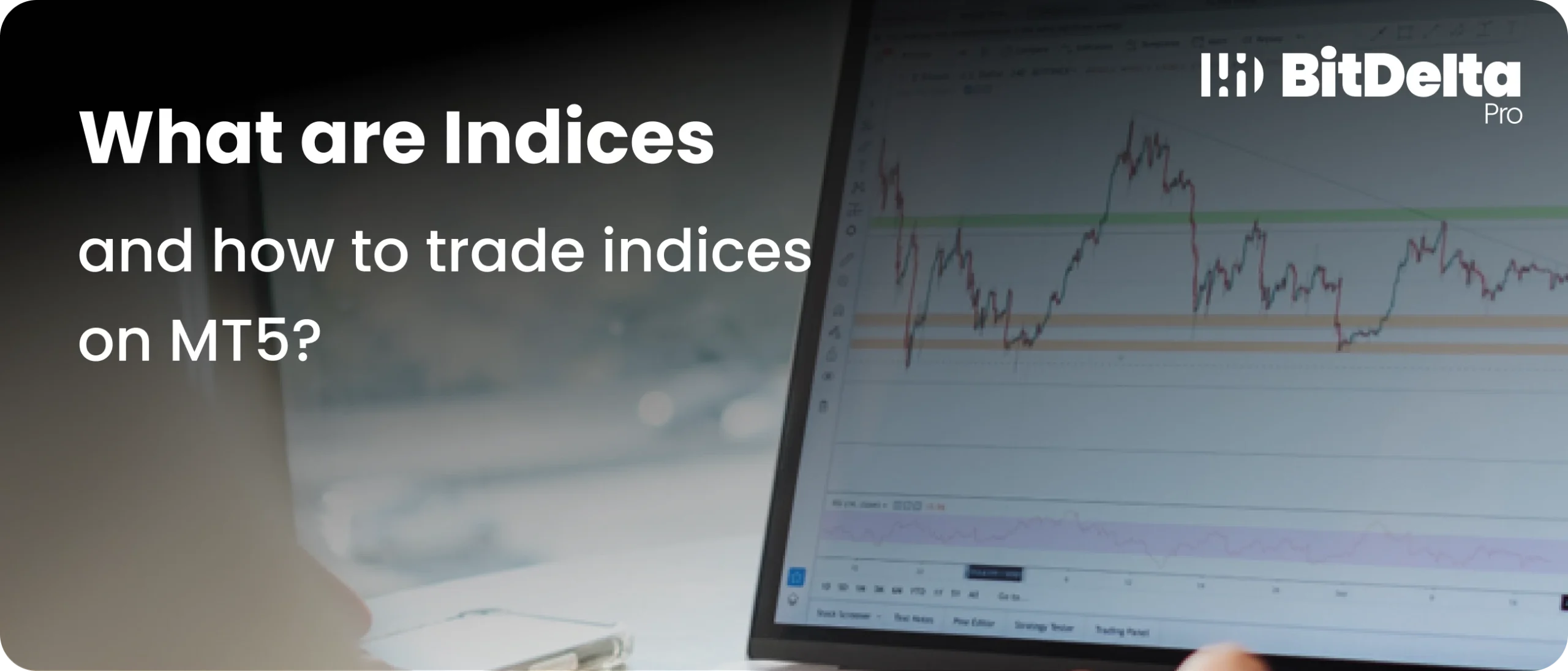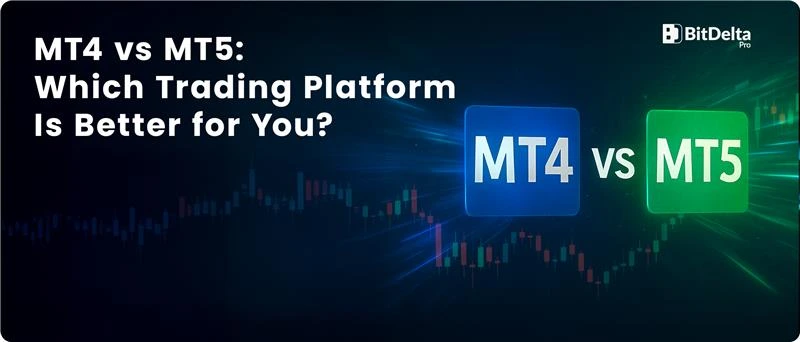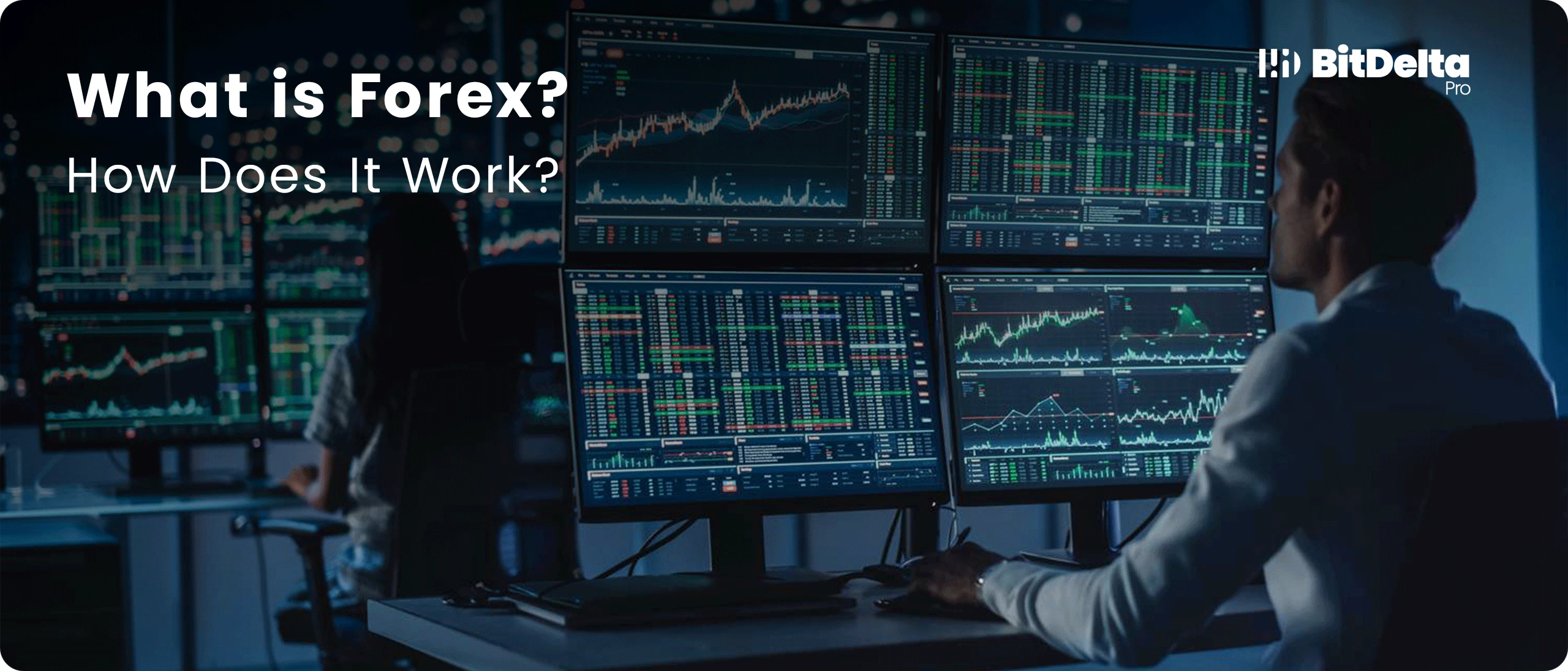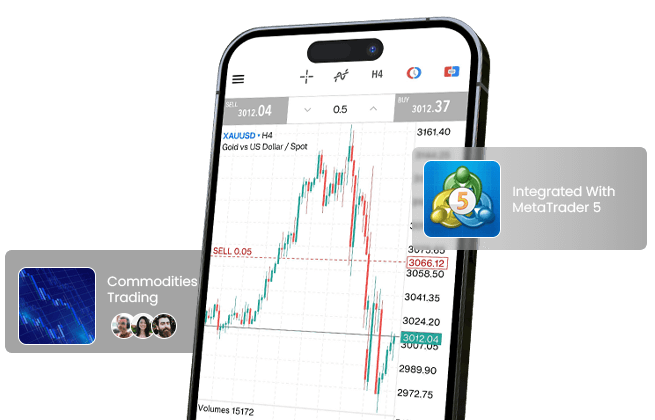Table of Contents
What are Indices and How to Trade Indices on MetaTrader 5?
8 MIN READ
Team BitDelta Pro • 02 Dec 2024

Trading indices allow you to monitor and profit from overall stocks in specific markets and sectors. MT5 offers advanced tools for a comprehensive experience when trading indices.
Key Takeaways
- Indices monitor the performance of a set of companies and expose larger market trends.
- Trading an index provides diversity and usually has lower volatility than trading a single stock.
- Through MetaTrader 5 (MT5), traders gain uninterrupted access to many global indices and receive sophisticated analysis and execution features.
- To successfully trade indices, traders must apply risk management strategies that emphasise stop-loss orders and effective leverage management.
Stock indices are among the most popular financial assets for traders worldwide. Indices trading can be helpful for individuals looking to follow larger market changes without investing in or monitoring single stocks. Below, we will explore stock indices and discuss their popularity with traders. We will also discuss how to start trading them on MetaTrader 5 and include best practices for trading and risk management.
What are Indices?
A stock index (plural indices) monitors the performance of a collection of stocks and provides traders with insight into the conditions of their chosen market or sector. Indices are essential tools for analysing market trends, as they reflect the overall changes in companies within a designated market. For example, the FTSE 100 index monitors the top 100 companies on the London Stock Exchange, allowing traders to observe the general movement of the market.
Below are a few more examples of popular indices:
- S&P 500: Monitors the leading 500 companies in the US stock market.
- Dow Jones Industrial Average (DJIA): Made up of the top 30 corporations in the US.
- Nasdaq Composite: Monitors 3000+ securities on the Nasdaq Stock Market, with special attention to tech companies.
- FTSE 100: Monitors the 100 major businesses traded on the London Stock Exchange.
- DAX 30: Made up of the 30 top-ranking enterprises on the Frankfurt Stock Exchange.
- Nikkei 225: Follows the top 225 businesses in the Tokyo Stock Exchange.
How are Indices Calculated?
- Market Capitalisation-Weighted Index: This type of valuation determines indices’ value by calculating the total market cap of the individual firms it includes. The bigger a company is, the greater its impact on the index. For example, the S&P 500 is market capitalisation-weighted, so its value depends more heavily on large enterprises like Apple and Microsoft.
- Price-Weighted Index: A price-weighted index relies on its companies’ valuations. The value of the index is greatly influenced by stocks with higher prices. For example, the DJIA illustrates a price-weighted index.
Why Trade Indices?
There are several reasons why traders tend to favour indices:
- Diversification: Each trading index represents numerous enterprises, providing quick diversification. When you invest in an index such as the S&P 500, you access 500 companies and manage your risk effectively across diverse business areas.
- Market Sentiment: Indices represent the current state of the whole stock market. Instead of focusing on individual stocks for profit opportunities, traders prefer to engage in indices trading that reflect wider market trends. When traders expect the market to rise, they will buy an index. With a predicted market drop, traders can borrow against an index.
- Lower Volatility Compared to Individual Stocks: As indices follow the outcomes of multiple companies, they usually experience reduced volatility compared to individual stocks. Indices give traders a safer choice to minimise risk and access market shifts.
- Popular Indices for Traders: Traders choose indices such as the S&P 500 and FTSE 100 because of their high trading volume and wide market access. With these indices, traders can reap rewards based on the performance of full economies or sectors.
- Although index trading has its perks, including diversification, it also bears risks. International financial situations and geopolitical risks can massively impact indices’ valuations. Because the majority of indices rely on big companies, their weighting or performance may shift the index’s total value.
Getting Started with Indices Trading on MetaTrader 5
MetaTrader 5 (MT5) is a leading platform for indices trading that offers practical features and equips traders with advanced analyses and execution tools.
Here is how you can get started trading indices on MT5.
Set Up an MT5 Account for Index Trading
The first step for trading indices on MT5 is to create an account with a broker that backs the platform. BitDelta Pro stands out as a platform offering a wide range of international indices. Once you set up your account, you can download MT5, make your first deposit, and start trading.
Adding Indices to Your Market Watch List
Once you establish your MT5 account, you can add indices to your market watch list by looking for the index you wish to trade. When added, you can monitor price trends and collect critical data, including spreads and contract sizes. Here is how they work:
- Leverage: Leverage is a major advantage of trading indices on MT5. With leverage, traders can oversee larger trades with a lower investment, magnifying returns. However, this also increases the potential for losses.
- Margin: By trading indices on margin, you essentially receive a loan from your broker to expand your position. The index choice and leveraging level determine the margin requirements on MT5.
- Spreads and Lot Sizes: Spreads show the difference between an index’s buying and selling prices. The competitive spreads found in MT5 benefit traders focused on cost reduction. The amount that traders risk varies with the lot size for specific indices.
How to Trade Indices on MetaTrader 5?
Placing a trade on MT5 is straightforward, and the platform offers several order types to suit different trading strategies.
1) Open the MT5 Platform: Visit the ‘Market Watch’ space to view accessible indices.
2) Select the Index: Select a trading index, such as the S&P 500 or FTSE 100, and view its chart.
3) Click ‘New Order’: An order window will open, allowing you to select your type of order and set the amount of your position.
4) Choose Order Type: Select one of the three types of orders:
- Market Orders: Completes right away at the prevailing market rate.
- Limit Orders: Triggers when the price gets to a target point.
- Stop Orders: Responds with an order that takes a position beyond or under the existing price when the market reaches a designated price.
5) Set-Levels: By setting Stop-Loss orders, you can minimise your losses, and with Take-Profit orders, you close out your position once the desired profit is reached.
6) Execute the Trade: Press ‘Buy’ or ‘Sell’ to complete the trade once you configure your settings. Once trades are initiated within MT5, you can track your existing positions, alter Stop-Loss or Take-Profit orders, and settle trades when needed.
Key Features of MT5 for Indices Trading
MetaTrader 5 offers several advanced features, which make it an excellent platform for trading indices:
- Advanced Charting Tools for Indices: MT5 offers extensive charting tools that allow traders to perform technical analysis on indices. Time frames can be adjusted on these charts, ranging from 1 minute to 1 month.
- Technical Analysis Indicators: MT5 offers more than 30 technical indicators, which can be decisive for traders.
- Time Frames and Market Depth for Indices: With MT5, traders can use alternative time frames to align with their trading methods. Typical day traders can concentrate on periods as short as 1 minute.
- Automated Trading with Expert Advisors (EAs): MT5 enables automated trading using Expert Advisors (EAs). Individuals can either build or buy EAs that facilitate trades governed by specific regulations or scripts. This feature is helpful for traders aiming to automate their strategies and take advantage of market opportunities without spending much time on the platform.
Trading Strategies for Indices
To effectively trade indices, you will need a well-organised strategy. Here are some approaches that traders commonly use:
- Fundamental Analysis for Indices: Such analysis involves assessing economic statistics and earnings alongside central bank statements to perform fundamental analysis. For example, if the US Federal Reserve decides to reduce interest rates, it might boost indices such as the S&P 500. By closely following macroeconomic trends, traders can choose the optimal time for entering and exiting trades.
- Long-Term vs. Short-Term Index Trading Strategies: Traders following a long-term strategy usually keep their positions for weeks or months, relying on key indicators such as earnings reports or economic trends. On the other hand, short-term traders aim to profit from short-term price movements within days or hours.
- Day Trading and Swing Trading Indices: Day traders initiate and complete trade within the same trading day by taking advantage of instantaneous price changes. On the other hand, swing traders focus on earning profits from changes in price across several days or weeks. The effectiveness of both methods varies according to the trader’s capacity for risk and the state of the market.
Risk Management for Indices Trading
When trading indices, an effective risk-management approach can safeguard your capital and help avoid major losses.
- Using Stop-Loss and Take-Profit Orders: When the market turns against you by a fixed amount, a Stop-Loss order automatically closes your trade to limit the losses or minimise future losses. Once your transaction earns a set amount, a Take-Profit order completes the trade, and you can maintain your profits without needing to monitor the market continuously.
- Managing Margin and Leverage in Index Trading: Margin trading lets you oversee larger positions at a lower investment; however, it increases risk. Gains and risks increases when using leverage; therefore, it is essential to handle it carefully. When you exceed margin requirements, your broker may ask for more funds to address potential losses.
- Mobile Trading for Indices on MetaTrader 5: The MT5 mobile app allows traders to trade indices at any time of the day. It has all the important features of the desktop version, allowing traders to engage with the markets conveniently from anywhere. The MT5 mobile app provides access to the latest price movements, customisable charts, and technical metrics. You can initiate or adjust trades from your mobile device or tablet to seize market opportunities.
If you are on the move, commuting, or travelling, the MT5 mobile app allows you to execute orders and monitor your active positions.
Benefits of Trading Indices on MetaTrader 5
Trading indices on MetaTrader 5 comes with several advantages:
- Access to Multiple Indices from Global Markets: On MT5, you can trade indices from diverse international markets, including the US, Europe, and Asia. This facilitates more variation and the opportunity to exploit prospects in several locations.
- Real-Time Market Data and Charting Tools: MT5 offers real-time pricing and top-notch charting solutions so traders can make informed decisions based on reliable market data.
- Multi-Asset Trading on a Single Platform: MT5 enables you to trade forex alongside commodities, equities, and ETFs while giving you access to various trading options on a single platform.
- Customisable Technical Indicators and Automated Trading: With MT5, you gain access to a deep library of technical indicators and enjoy the integration of automated trading using Expert Advisors (EAs). This feature allows traders to refine their methods while leveraging automatic market reactions.
Final Words
Using MetaTrader 5 has many benefits, including advanced tools for technical analysis and execution of indices trading orders. Mastering MT5’s functions and forming a strong trading approach allows you to engage with global indices markets and profit from market opportunities.
Join BitDelta Pro and launch your index trading journey with the integrated MetaTrader 5 easily.
DISCLAIMER
This communication is for informational and educational purposes only and should not be construed as financial, investment, or legal advice. BitDelta Pro does not guarantee the accuracy, completeness, or timeliness of the information provided. Trading in traditional securities (such as forex currency pairs, stocks, bonds, and commodities) carries inherent risks, including potential loss of principal. Users are encouraged to carefully evaluate their financial objectives, conduct their own research, and seek independent financial advice before making any trading decisions. BitDelta Pro is not liable for any losses or damages resulting from actions taken in response to this communication.
Register an Account
Start your trading journey and explore limitless trading opportunities

Sign up today and gain access to global markets!
Register Now



;?>)